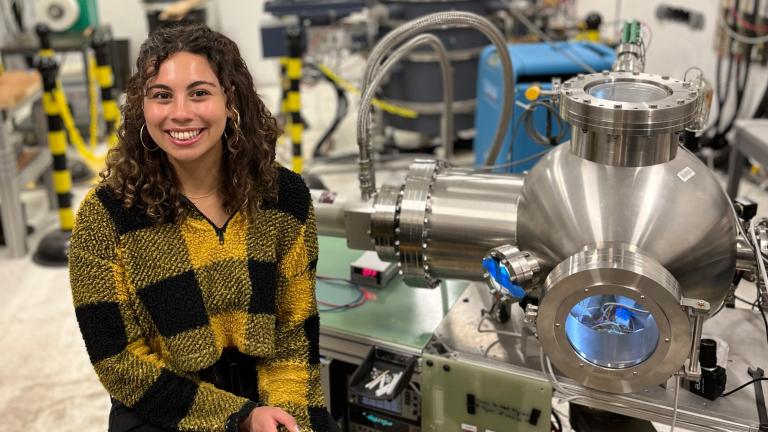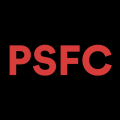
“I catch myself startling people in public.”
Zoe Fisher’s animated hands carry part of the conversation as she describes how her naturally loud and expressive laughter turned heads in the streets of Yerevan. There during MIT’s Independent Activities period (IAP), she was helping teach nuclear science at the American University of Armenia, before returning to MIT to pursue fusion research at the Plasma Science and Fusion Center (PSFC).
Startling people may simply be in Fisher’s DNA. She admits that when she first arrived at MIT, knowing nothing about nuclear science and engineering (NSE), she chose to join that department’s Freshman Pre-Orientation Program (FPOP) “for the shock value.” It was a choice unexpected by family, friends, and mostly herself. Now in her senior year, a 2021 recipient of NSE’s Irving Kaplan Award for academic achievements by a junior and entering a fifth-year master of science program in nuclear fusion, Fisher credits that original spontaneous impulse for introducing her to a subject she found so compelling that, after exploring multiple possibilities, she had to return to it.
Fisher’s venture to Armenia, under the guidance of NSE associate professor Areg Danagoulian, is not the only time she has taught oversees with MISTI’s Global Teaching Labs, though it is the first time she has taught nuclear science, not to mention thermodynamics and materials science. During IAP 2020 she was a student teacher at a German high school, teaching life sciences, mathematics, and even English to grades five through 12. And after her first year she explored the transportation industry with a mechanical engineering internship in Tuscany, Italy.
By the time she was ready to declare her NSE major she had sampled the alternatives both overseas and at home, taking advantage of MIT’s Undergraduate Research Opportunities Program (UROP). Drawn to fusion’s potential as an endless source of carbon-free energy on earth, she decided to try research at the PSFC, to see if the study was a good fit.
Much fusion research at MIT has favored heating hydrogen fuel inside a donut-shaped device called a tokamak, creating plasma that is hot and dense enough for fusion to occur. Because plasma will follow magnetic field lines, these devices are wrapped with magnets to keep the hot fuel from damaging the chamber walls.
Fisher was assigned to SPARC, the PSFC’s new tokamak collaboration with MIT startup Commonwealth Fusion Systems (CSF), which uses a game-changing high-temperature superconducting (HTS) tape to create fusion magnets that minimize tokamak size and maximize performance. Working on a database reference book for SPARC materials, she was finding purpose even in the most repetitive tasks. “Which is how I knew I wanted to stay in fusion,” she laughs.
Fisher’s latest UROP assignment takes her — literally — deeper into SPARC research. She works in a basement laboratory in building NW13 nicknamed “The Vault,” on a proton accelerator whose name conjures an underworld: DANTE. Supervised by PSFC Director Dennis Whyte and postdoc David Fischer, she is exploring the effects of radiation damage on the thin HTS tape that is key to SPARC’s design, and ultimately to the success of ARC, a prototype working fusion power plant.
Because repetitive bombardment with neutrons produced during the fusion process can diminish the superconducting properties of the HTS, it is crucial to test the tape repeatedly. Fisher assists in assembling and testing the experimental setups for irradiating the HTS samples. Fisher recalls her first project was installing a “shutter” that would allow researchers to control exactly how much radiation reached the tape without having to turn off the entire experiment.
“You could just push the button — block the radiation — then unblock it. It sounds super simple, but it took many trials. Because first I needed the right size solenoid, and then I couldn’t find a piece of metal that was small enough, and then we needed cryogenic glue…. To this day the actual final piece is made partially of paper towels.”
She shrugs and laughs. “It worked, and it was the cheapest option.”
Fisher is always ready to find the fun in fusion. Referring to DANTE as “A really cool dude,” she admits, “He’s perhaps a bit fickle. I may or may not have broken him once.” During a recent IAP seminar, she joined other PSFC UROP students to discuss her research, and expanded on how a mishap can become a gateway to understanding.
“The grad student I work with and I got to repair almost the entire internal circuit when we blew the fuse — which originally was a really bad thing. But it ended up being great because we figured out exactly how it works.”
Fisher’s upbeat spirit makes her ideal not only for the challenges of fusion research, but for serving the MIT community. As a student representative for NSE’s Diversity, Equity and Inclusion Committee, she meets monthly with the goal of growing and supporting diversity within the department.
“This opportunity is impactful because I get my voice, and the voices of my peers, taken seriously,” she says. “Currently, we are spending most of our efforts trying to identify and eliminate hurdles based on race, ethnicity, gender, and income that prevent people from pursuing — and applying to — NSE.”
To break from the lab and committees, she explores the Charles River as part of MIT’s varsity sailing team, refusing to miss a sunset. She also volunteers as an FPOP mentor, seeking to provide incoming first-years with the kind of experience that will make them want to return to the topic, as she did.
She looks forward to continuing her studies on the HTS tapes she has been irradiating, proposing to send a current pulse above the critical current through the tape, to possibly anneal any defects from radiation, which would make repairs on future fusion power plants much easier.
Fisher credits her current path to her UROP mentors and their infectious enthusiasm for the carbon-free potential of fusion energy.
"UROPing around the PSFC showed me what I wanted to do with my life,” she says. “Who doesn't want to save the world?"






